An Overview of the Different Metal Fabrication Processes
Metal fabrication refers to a process that manipulates and alters metal material into a final product. Unlike other processes that use ready-made components to assemble end products, fabrication uses raw or semi-finished materials by cutting, shaping, or molding them. A popular end product of metal fabrication is cellular steel beams, which are sturdy pieces often found in steel parking garage structures, office buildings, and even major sports stadiums.
Manufacturers use various metal types and alloys when making metal fabricated products, ranging from aluminum, copper, gold, silver, and steel. Here are a few of the different kinds of metal fabrication:
Casting
In this type of metal fabrication, molten metal is poured into a mold or die, allowing it to cool off. It then starts hardening into the intended shape, making the process practical for mass-producing identical products.
There are many different types of casting. For instance, die-casting is a process that involves forcing liquid metal into a die instead of a mold. Then, the worker applies pressure to make sure it stays in place until it hardens. Another type of casting is semi-permanent mold casting, where the molten metal is poured into molds with expendable cores, making them easier and cheaper to remove.
Cutting
Cutting is a common fabrication type that involves slicing a metal workpiece to divide it into smaller sections. The oldest method of cutting involved sawing, which was often labor-intensive and time-consuming. However, thanks to technology, workers now use modern cutting techniques like laser cutting, power scissors, and water jet cutting. They can also choose to cut manually, opt for power tools, or use computer numerical computer cutters.
Drawing
In this process, drawing pulls metal into and through a tapered die, stretching the metal into a smaller, thinner sheet. Drawing is often done at room temperature, earning the nickname of cold drawing. However, it can be subjected to heat to reduce the force needed to pull the metal through the die, called deep drawing. This method is used with sheet metal fabrication to convert metal sheets into hollow vessels, whether cylindrical or box-shaped.
Forging
Forging shapes metal using compressive force, such as a hammer or a die, repeatedly striking the metal workpiece until achieving the intended shape. When performed at room temperature, it is called cold forging. Like drawing, this process can be performed with metal heated well above room temperature to just under recrystallization temperature, called warm forging. Once the temperature reaches recrystallization levels, it is then called hot forging. It is one of the oldest types of metal fabrication, with the first blacksmiths using forging to work with metal.
Welding
Welding involves joining two or more metal pieces through heat and pressure, making it one of the most popular metal fabrication processes. It allows workers to create metal pieces of any shape or size using some of the most commonly used welding procedures: stick or arc welding, MIG welding, TIG welding, and flux-cored arc welding.
Stick welding uses an electrode stick that produces an electric arc when it touches the metal. The arc’s hot temperature welds the metal. Meanwhile, Metal Inert Gas (MIG) welding uses a secondary source of gas and solid wire electrode to protect the metal from reacting to outside factors, allowing the welding to finish without interruption. Tungsten Inert Gas (TIG) is similar to stick welding because it uses a tungsten electrode rod, producing a shorter arc to weld heavier metals. Lastly, flux-cored arc welding is similar to MIG welding, although the wire electrode has a core that makes gas, eliminating the need for an external gas supply.
Conclusion
Metal fabrication processes have undergone multiple developments over the years, making them easier and more efficient. It also allows manufacturers to create various metal materials proven useful in many industries, especially the construction sector. By understanding the basics of metal fabrication and its many processes, you’ll know more about what goes into making materials like cellular steel beams.
C-Beams is a proud supplier of innovative structural solutions and products. As steel beam manufacturers, we provide fabricated structural welded sections of different shapes and sizes, accommodating construction and manufacturing applications of all kinds. Contact us today to find out more about our cellular steel beams!




